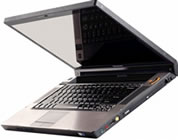Netbooks
Netbooks are a rising contender in the mobile sector that were given a breath of life by Asus with their Eee PC back in 2007. Netbooks are essentially miniature-sized, energy efficient laptops that benefit the user in both cost and mobility.
They commonly feature 7"-12" displays and utilize Intel's Atom CPU, solid state or low RPM storage drives, integrated graphics and often ship with a Linux distribution for an operating system, although, Windows is readily available as an option on most models nowadays.
Component
|
Netbook Standard
|
Netbook Upgraded
|
| Processor: | Intel Atom N270 1.60GHz | Intel Atom N280 1.66GHz |
| RAM: | 512MB - 1GB DDR2 533MHz/667MHz | 2GB DDR2 667MHz |
| Video: | Intel GMA 950 | Nvidia GeForce 9300M GS |
| Audio: | Integrated audio | |
| HDD: | 8GB - 40GB SSD / 60GB - 120GB HDD | 160GB - 320GB HDD |
| Optical: | None | |
| Network: | Integrated 10/100/1000 Ethernet | |
| Wireless: | Internal 802.11 g/n and Bluetooth | |
| Display: | 8.9" - 10.1" LCD | 10.1"-12" LED backlit panel |
| Battery: | 3 - 6 Cell Lithium Ion | 3 - 6 Cell Lithium Ion |
Interfaces you may require: |
2+ USB 2.0 ports, Headphone/Mic jacks, Multi-card reader slot, VGA port, Cable lock slot | 3+ USB 2.0 ports, Headphone/Mic jacks, Multi-card reader slot, VGA port, Cable lock slot |
Internally, almost all of the netbooks you'll come across will be comprised of the same fundamental hardware, except for RAM and storage configurations, which is easy enough to choose. Some of the more costly models might offer a minor CPU or graphics upgrade, but from a logical standpoint, you shouldn't lay down an additional $200+ for an Nvidia GeForce 9300M GS when you won't need it anyway.
What should be looked at a bit more strictly in netbooks, are seemingly superficial external variations between manufacturers as seen in our Netbook Round-up. These differences might be most easily overlooked with larger laptops because traditional standards are typically followed. Having an absolutely unconventional or unintuitive interface layout can truly break the user's experience and have them begging for their money back.
We recommend you stick with screen sizes that are 8.9" or above and try to keep it under $400, otherwise you may as well just buy a standard/budget laptop for $600 and up.
